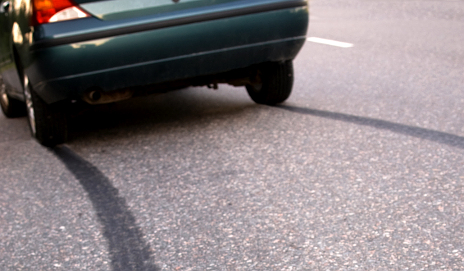“Presuming that the hub and wheel flange are flat and in good condition and that the wheel bolts or hat mounting hardware is in good condition, installed correctly, and tightened uniformly and in the correct order to the recommended torque specification, in more than 40 years of professional racing…I have never seen a warped brake disc,” said Smith, who authored StopTech’s white paper on the topic. “I have seen lots of cracked discs, discs that had turned into shallow cones at operating temperature because they were mounted rigidly to their attachment bells or top hats, a few where the friction surface had collapsed in the area between straight radial interior vanes, and an untold number of discs with pad material unevenly deposited on the friction surfaces — sometimes visible and more often not.”
Smith says every vibration issue he’s seen attributed to a warped brake disc has actually turned out to be friction pad material that was transferred unevenly to the surface of the rotor. This uneven build-up results in thickness variation (TV) or run-out due to hot spotting that occurred at elevated temperatures.
Smith explains how the problem occurs by taking a more in-depth look at the nature of braking friction in his white paper. The bottom line, though, is you must properly break in your brake pads and rotors to prevent materials from transferring between surfaces in a random fashion. This allows the bonding resins to be burned off slowly to prevent uneven deposits and fade. The right break-in procedure will also relieve any thermal stresses on new brake rotors and will transfer a smooth layer of pad material onto the disc.
It’s also important to choose the right brake pad materials for your driving style. According to Smith, there is no such thing as an ideal all-around brake pad. For example, a friction material that is quiet and functions at low temperatures around town won’t stop a car that’s being driven hard. A true racing pad, used under normal conditions, will be noisy and not work well at low temperatures around town.
So what pad should be used in high performance street cars?
“The answer is a high performance street pad with good low temperature characteristics,” Smith stated. “The reason is simple: If we are driving really hard and begin to run into trouble, either with pad fade or boiling fluid, the condition comes on gradually enough to allow us to simply modify our driving style to compensate. On the other hand, should an emergency occur when the brakes are cold, the high temperature pad is simply not going to stop the car.”
Again, the right pads, mounting procedures, and pad/rotor break-in process are key to avoiding dreaded brake judder.
…
Myth #2: A Soft Pedal is the Result of Pad Fade
A mushy brake pedal is caused by overheated brake fluid, not overheated pads. According to Smith, there are two causes of brake fade:
- The temperature at the interface between the pad and the rotor exceeds the thermal capacity of the pad. This causes the pad to lose friction capability due largely to binding agent outgassing in the pad compound. In this situation, the brake pedal remains firm and solid, but the car won’t stop. The first indication of this condition is a distinctive, unpleasant smell.
- Boiling brake fluid in the calipers causes air bubbles to form. Since air is compressible, the brake pedal becomes soft and “mushy” and pedal travel increases. You can usually still stop the car by pumping the pedal, but efficient modulation is gone.
…
Myth #3: The Brake Fluid Reservoir Should Be Topped Off
In modern passenger cars, the brake fluid reservoir is designed with a specific volume and equipped with an internal float. The volume corresponds to the amount of fluid displaced when the pads have worn to the replacement point.
Then, the descending float completes an electrical circuit and a dash light appears warning the driver that the pads should be replaced.
“If the brake fluid is topped up, the first warning of worn-out pads will be the screech of steel backing plate against iron disc,” Smith said.


The second two make perfect sense. Physical deterioration by heat, and changing a sensor mechanical input to a level uncalibrated.
The first..,
I drive my car sometimes to its limit. Getting the machine to operate correctly in all speeds, and driving conditions has been a lot of experimenting. Everything that becomes a weak link is replaced with something many times better.
Brake rotor warped. A brake rotor that looks like a vinyl lp (record) subjected to periodic excessive heat for a decade. I’ve done it twice. Second time with cross drilled slotted rotors. To find out slotted alone are better. Premium pads wear great. Stoptech has already been planned as my next set. If you have never seen a warped rotor I have three of them. I torque everything to spec, break in, check everything two days after installation. Camber, pressures, etc. all accounted for. Bearings, boots, links, all have had attention, and inspection.
Every time fresh rotors have been installed. Everything is absolutely perfect. Couldn’t ask for any better. A few months of abuse, and one good hour of extreme braking leaves them unstable after for speeds over 70 mph.
I’m sure Stoptech’s materials, and manufacturing will exceed brands I have tried. I do however feel certain that metal under severe centrifugal, compression, and heat stresses. Will deform.
You described my GM JB6 brakes perfectly..aside of course from the occasional rear wheel cyl explosions..but otherwise spot on!!!
So if the rotors have unevenly embedded friction material causing a shudder, can you just cut the rotors?
yes, but the article basicly says that once the build up occurs the rotor gets runout damage due to hot and cold spots.
A brake rotor and fly wheel/pressure plate. When you say “cut’ that refers to having the resurfaced on a lathe. When hot/hard spot goes by the cutter, it can be pushed up, ever so slightly. Grinders eliminate the high/hot spot. Flywheels have been ground for some time as standard procedure. Brake rotors, not so much. Even new ones are often turned instead of ground. Go with ground rotors when ever you can.
“Expert”….
Good article. I learned the hard way about filling a master cylinder up too much. When the brakes and fluid are cold, they displace a certain volume. Heat the brakes up and the fluid expands. If the master cylinder is overfilled, the fluid will push on the pistons and the brakes will drag. I’ve seen guys blame hoses, calipers, pads, etc. Take out some fluid from the master, and BAM! The brakes release as intended. Oh, and it’s real fun on a motorcycle when this happens. Ask me how I know!
[…] Three Common Brake System Myths […]
[…] because it can cause wheel vibration or a pulsing brake pedal. In fact, we’ve seen plenty of misdiagnosed “warped” rotors that were instead caused by a rusty, gritty hub […]
Sorry, but myth #1 is often absolutely true. I’ve replaced a bunch of warped rotors. The worst vehicles in my experience are the Chevy Trailblazer/Envoy,etc.
Replacing the Trailblazer rotors with the larger version from the extended wheelbase TB seems to help a bunch
I used to work for a parts store, as did a friend. I can tell you with 100% certainty, that warped rotors DO exist. Usually, it is do to improper storage while sitting on shelves, but I can’t rule out inferior metals or manufacturing. We have both put brand new white box rotors on the machine & turned them to make them true. They have never had a pad on them, but it is quite obvious, through sight & sound that the surfaces are not true.